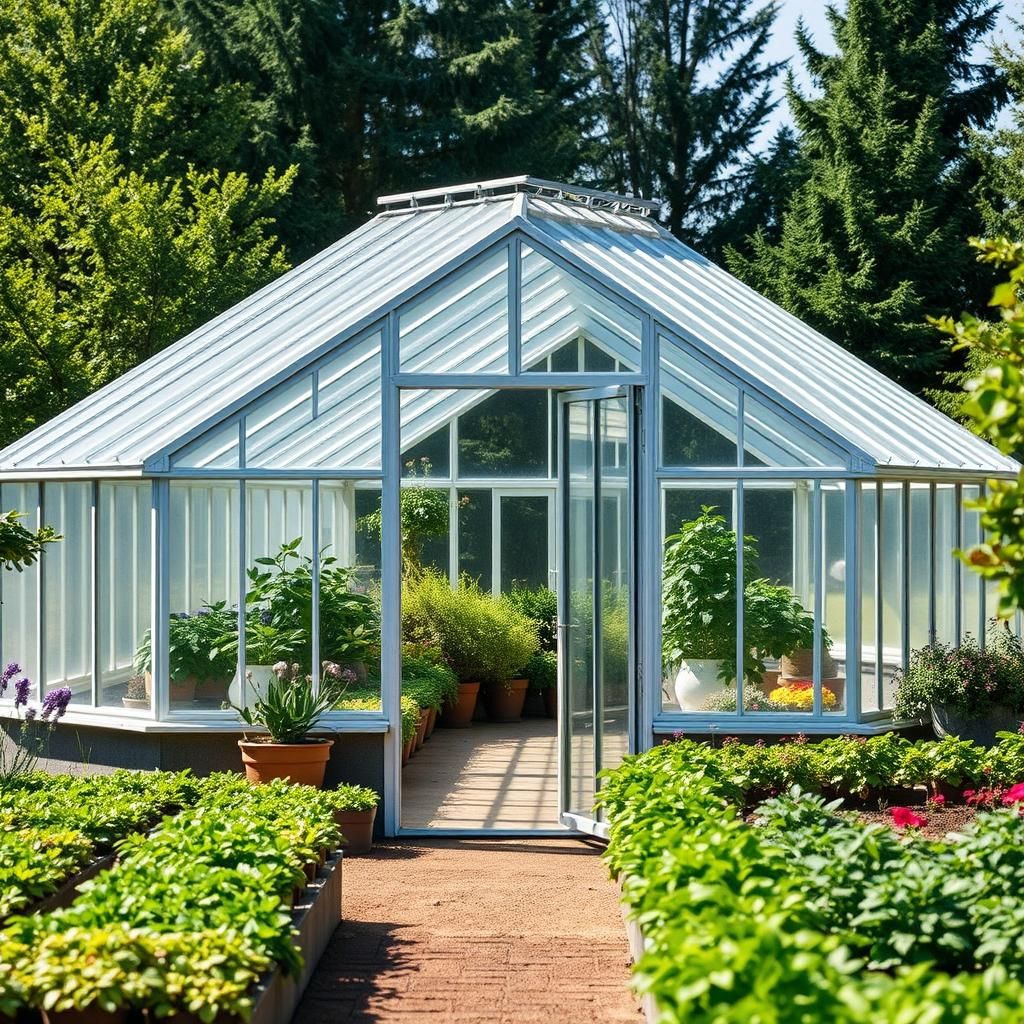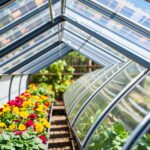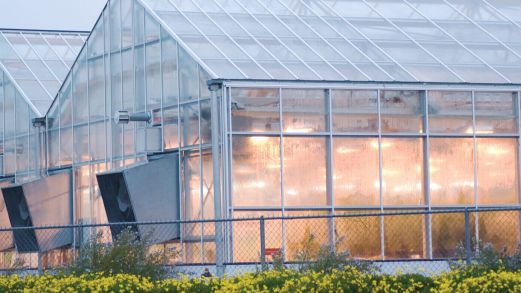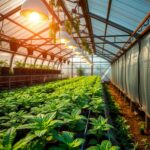What are the Disadvantages of Polycarbonate Greenhouses? Uncovering the Drawbacks Before You Buy

Polycarbonate greenhouses are increasingly popular among gardening enthusiasts and commercial growers due to their durability and insulation properties. However, like any structure, they come with their set of disadvantages that potential buyers should carefully consider. This article aims to uncover the drawbacks of polycarbonate greenhouses, examining factors such as cost, maintenance challenges, and potential limitations in light transmission. By understanding these nuances, you can make an informed decision about whether a polycarbonate greenhouse is the right choice for your gardening needs. Dive in as we explore the crucial aspects to consider before investing in this growing trend.
Disadvantages of Polycarbonate Greenhouses
Polycarbonate greenhouses, although popular for their durability and insulation properties, come with several disadvantages that potential buyers should consider. One major issue is that they can be costly upfront compared to other materials like plastic or glass. Furthermore, polycarbonate panels can be prone to scratches and may become cloudy over time, reducing light transmission and affecting plant growth. They also require careful installation to prevent leaks and condensation buildup, which can lead to mold and pest problems. Additionally, while polycarbonate does provide good insulation, it may struggle to maintain optimal temperatures in extreme weather conditions, potentially affecting the plants inside.
Cost Considerations
Despite their long-term durability, the initial purchase and installation costs of polycarbonate greenhouses can be significantly higher than other options. This initial investment may deter gardeners or growers who are just starting or those with a limited budget. It's important to factor in not just the cost of the panels, but also the framework, foundation, and any necessary accessories for proper installation.
Maintenance Requirements
Regular maintenance is necessary to keep polycarbonate greenhouses in optimal condition. While they may not require as much upkeep as traditional glass structures, cleaning the panels to prevent dirt buildup and checking for any signs of wear and tear is essential. Neglecting these aspects can lead to reduced light levels and compromised structural integrity over time.
Light Transmission Issues
One significant drawback of polycarbonate greenhouses is that their panels can become cloudy with time, decreasing the amount of natural light that penetrates into the greenhouse. Proper light is crucial for plant growth, and diminished light levels can hinder photosynthesis, potentially leading to stunted growth or reduced yields.
Temperature Control Challenges
While polycarbonate offers good insulation properties, it may not effectively regulate temperatures in extremely hot or cold climates. During hot days, excess heat can build up inside the greenhouse, harming sensitive plants, while during colder nights, inadequate insulation might not prevent temperature drops that could damage crops. Hence, growers may need to implement additional ventilation or heating systems.
Potential for Pests and Mold
The design of polycarbonate greenhouses can create environments conducive to the development of pests and mold if not properly maintained. If excess moisture accumulates, particularly in poorly ventilated areas, it can lead to issues such as mold growth and attract unwanted insects, which may necessitate additional pest control measures and reduce the overall effectiveness of the greenhouse.
| Disadvantage | Impact |
|---|---|
| Cost | Higher initial investment |
| Maintenance | Regular upkeep required |
| Light Transmission | Reduced light affecting growth |
| Temperature Control | Difficulties in extreme weather |
| Pests and Mold | Potential for increased issues |
What is the problem with polycarbonate greenhouses?

Polycarbonate greenhouses are popular due to their durability and insulation properties, but they also have several issues that can affect their performance and longevity. Here’s a detailed look at the problems associated with polycarbonate greenhouses.
Durability and Impact Resistance
Polycarbonate is often praised for its strength, but it is not entirely impact-proof. Over time, it can suffer from cracks or shattering, especially in regions with extreme weather conditions. Factors contributing to this include:
- Extreme temperature fluctuations that lead to expansion and contraction.
- Hail or falling debris that can cause physical damage.
- Improper installation or use of inadequate framing materials that cannot withstand stress.
UV Degradation
While polycarbonate materials often have UV-resistant coatings, prolonged exposure to sunlight can still lead to degradation and yellowing. This may reduce the greenhouse's effectiveness in filtering light and maintaining a healthy environment for plants. Key issues include:
- Loss of clarity, resulting in diminished light transmission.
- Reduced structural integrity due to weakened properties of the material over time.
- Increased maintenance costs or the need for replacement panels.
Heat Retention Issues
Polycarbonate greenhouses are designed to retain heat, but poorly insulated models can suffer from excess heat loss during cold nights. This can lead to:
- Increased energy costs for heating systems.
- Insufficient temperature control that affects plant growth.
- Elevated risk of frost damage when temperatures drop unexpectedly.
Condensation Problems
Polycarbonate can trap moisture inside the greenhouse, leading to condensation issues. When not managed properly, this can create a humid environment conducive to fungal infections. Problems include:
See also:
- Formation of water droplets that can drip onto plants, promoting disease.
- Reduced air circulation that intensifies humidity levels.
- Potential for mold and mildew growth, impacting plant health.
Cost and Installation Complexity
While polycarbonate greenhouses can be more affordable than glass options, the initial investment can still be significant. Furthermore, installation can be complex, leading to:
- Costs associated with professional installation if expertise is lacking.
- Hidden expenses for frame materials and additional fittings.
- The need for specialized tools or knowledge to ensure a secure and effective assembly.
Is it better to have glass or polycarbonate in a greenhouse?

When it comes to choosing between glass and polycarbonate for a greenhouse, several factors come into play. Each material has its own advantages and disadvantages, which can significantly impact plant growth, structural durability, and maintenance requirements.
Durability
The durability of greenhouse materials is crucial for long-term use.
- Glass is highly durable when intact but can be fragile and susceptible to breakage, especially during severe weather events.
- Polycarbonate, on the other hand, is significantly more impact-resistant, making it less likely to shatter under stress or during hail storms.
- In terms of lifetime, while glass can last for decades, polycarbonate typically has a lifespan of around 10-15 years but is often easier to replace when damaged.
Insulation Properties
Insulation is a key factor in managing greenhouse temperatures effectively.
- Glass, while providing a beautiful aesthetic, has lower insulation properties, allowing heat to escape more quickly during cold nights.
- Polycarbonate, especially multi-wall options, contains air pockets that enhance insulation, keeping the greenhouse warmer in winter and cooler in summer.
- This improved insulation helps create a more stable climate for plants, which can lead to healthier growth overall.
Light Transmission
Light is essential for photosynthesis, so the light transmission capabilities of the materials are critical.
- Glass offers excellent light transmission rates, often above 90%, which is beneficial for plant growth.
- Polycarbonate also provides good light transmission but can vary depending on the type (clear, diffused), with clear polycarbonate achieving light transmission rates of about 80-90%.
- However, polycarbonate can diffuse light better, which may prevent hot spots and promote more uniform plant growth.
Cost Considerations
Budget is a substantial consideration in greenhouse construction.
- Glass greenhouses tend to be more expensive to install due to the cost of materials and the need for a more robust framing system.
- Polycarbonate is generally cheaper and easier to install, which can significantly lower initial setup costs.
- Long-term maintenance costs should also be considered, as glass may require more frequent repairs/replacements, whereas polycarbonate is more forgiving.
Maintenance Requirements
Regular maintenance is vital to ensure optimal functionality.
- Glass requires more maintenance in terms of cleaning, as debris and dirt can accumulate and block light; broken panels also need to be replaced promptly.
- Polycarbonate is easier to maintain due to its lightweight nature and is less prone to breakage; it just needs regular cleaning to maintain light transparency.
- Additionally, polycarbonate panels are often treated to resist UV damage and yellowing, which reduces upkeep frequency compared to glass.
What is the life expectancy of a polycarbonate greenhouse?

The life expectancy of a polycarbonate greenhouse generally ranges from 10 to 25 years, depending on several factors such as usage, maintenance, environmental conditions, and the quality of materials used in construction. Polycarbonate is known for its durability and resistance to extreme weather conditions, which contributes to its longevity compared to traditional glass greenhouses.
Factors Affecting Life Expectancy
The lifespan of a polycarbonate greenhouse can be influenced by a variety of factors:
- Material Quality: Higher quality polycarbonate panels are more resistant to UV light and impacts, extending the greenhouse's life.
- Weather Conditions: Locations with harsh weather, such as high winds, heavy snow, or extreme temperatures, can significantly shorten the lifespan.
- Maintenance Practices: Regular cleaning, repairs, and inspections can help maintain structural integrity and prolong lifespan.
Types of Polycarbonate Panels
Different types of polycarbonate panels can affect the greenhouse's durability:
- Single-Wall Panels: These are less expensive but provide minimal insulation and are usually less durable than multi-wall panels.
- Double-Wall Panels: Offer better insulation and strength, making them a popular choice for longevity.
- Triple-Wall Panels: Provide the best insulation and resistance, offering the longest life expectancy among polycarbonate options.
Environmental Impact
The environment plays a crucial role in determining how long a polycarbonate greenhouse will last:
See also:
- Sun Exposure: Prolonged exposure to sunlight can degrade polycarbonate over time, although many panels are treated to resist UV damage.
- Humidity Levels: Excess moisture can lead to mold growth and structural issues, potentially reducing lifespan.
- Temperature Fluctuations: Extreme temperature changes may cause expansion and contraction, which can weaken the material over time.
Maintenance Tips for Longevity
Proper maintenance can significantly enhance the life expectancy of polycarbonate greenhouses:
- Regular Inspections: Check for wear and tear, especially on seals and frames, to ensure everything remains secure.
- Cleaning: Keep the panels clean from dirt, debris, and algae growth, which can block sunlight and promote deterioration.
- Address Repairs Promptly: Fix any damages immediately to prevent further issues and extend the life of the greenhouse.
Cost Considerations
Understanding the cost can help justify the investment in a polycarbonate greenhouse:
- Initial Investment: While polycarbonate panels can be more expensive than glass, their longevity often makes them cost-effective in the long run.
- Operational Costs: Over time, a well-maintained polycarbonate greenhouse may incur lower energy costs due to better insulation.
- Resale Value: A well-maintained greenhouse can retain a higher resale value compared to less durable structures.
What are the negative effects of polycarbonate?

Polycarbonate, a type of thermoplastic, is widely used in various applications ranging from eyewear lenses to construction materials. Despite its transparency and impact resistance, polycarbonate can have several negative effects on both health and the environment.
Health Risks Associated with Polycarbonate
Polycarbonate is known to contain bisphenol A (BPA), a chemical that has raised health concerns due to its endocrine-disrupting properties. Prolonged exposure to BPA can lead to various health issues.
- Hormonal Imbalance: BPA mimics estrogen, potentially leading to hormonal disruptions.
- Reproductive Issues: Studies have linked BPA exposure to reproductive disorders in both men and women.
- Increased Cancer Risk: Some research indicates that BPA exposure may increase the risk of certain cancers, including breast and prostate cancer.
Environmental Impact of Polycarbonate
The production and disposal of polycarbonate can have significant environmental consequences. It is not biodegradable and contributes to plastic pollution.
- Plastic Pollution: Discarded polycarbonate products can persist in the environment for hundreds of years.
- Resource Depletion: The extraction of fossil fuels for polycarbonate production leads to depletion of natural resources.
- Toxic Emissions: The production process can release harmful chemicals into the atmosphere, impacting air quality.
Physical Properties and Limitations
While polycarbonate is renowned for its strength and durability, it has physical limitations that can raise concerns in certain applications.
- Scratch Vulnerability: Without surface treatments, polycarbonate can scratch easily, compromising its integrity.
- Heat Sensitivity: Polycarbonate can warp or lose structural strength when exposed to high temperatures.
- UV Degradation: Over time, UV exposure can cause polycarbonate to become brittle and yellowed, reducing its effectiveness.
Impact on Aquatic Life
When polycarbonate products enter water systems, they can negatively affect aquatic ecosystems. This poses risks not only to wildlife but also to human health through contaminated water sources.
- Microplastic Formation: As polycarbonate degrades, it can break down into microplastics, which are harmful to aquatic organisms.
- Toxic Effects on Marine Life: Chemicals leached from polycarbonate can be toxic to fish and other marine species.
- Bioaccumulation: Toxic substances can accumulate in the food chain, potentially impacting human health through seafood consumption.
Alternatives to Polycarbonate
Given the negative effects associated with polycarbonate, exploring alternative materials may be beneficial for various applications.
- Glass: While heavier, it is non-toxic and can provide similar optical clarity without the harmful effects of BPA.
- Biodegradable Plastics: Options made from renewable resources that offer less environmental impact.
- Recycled Plastics: Utilizing recycled materials can reduce waste and minimize the need for new resource extraction.
Questions from Our Readers
What are the main cons of polycarbonate greenhouses?
Polycarbonate greenhouses have several drawbacks, including their relatively high initial cost compared to other materials like plastic or glass. Additionally, they may not provide the same level of insulation as traditional glass greenhouses, which can impact temperature regulation.
Do polycarbonate greenhouses require more maintenance?
Yes, polycarbonate greenhouses can require more frequent maintenance compared to other materials. While they are durable, they can become scratched or clouded over time, leading to a need for regular cleaning and possibly replacement of panels.
Are polycarbonate greenhouses prone to UV degradation?
Although polycarbonate is designed to resist UV light, exposure over time can lead to yellowing or brittleness, affecting its durability and appearance. This degradation can compromise the greenhouse's effectiveness in providing a suitable growing environment.
How does the weight of polycarbonate affect greenhouse design?
Polycarbonate is relatively lightweight, which can be a disadvantage when designing larger greenhouses that require robust structural support. This can limit the design options and may necessitate more frequent reinforcement to withstand environmental stresses such as wind or snow.
See also:

If you want to read more articles like What are the Disadvantages of Polycarbonate Greenhouses? Uncovering the Drawbacks Before You Buy, we recommend you check out our Greenhouse category.
Leave a Reply
Related Articles